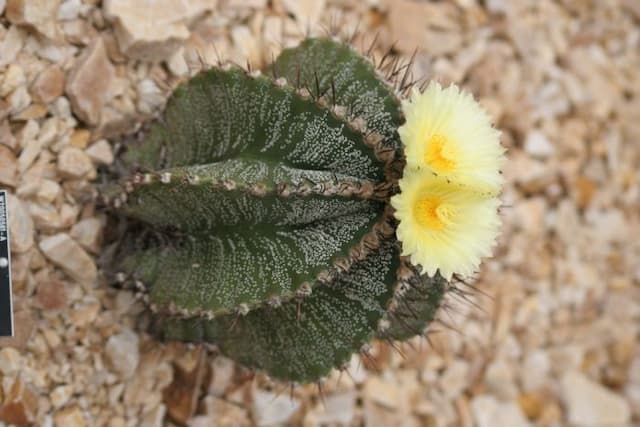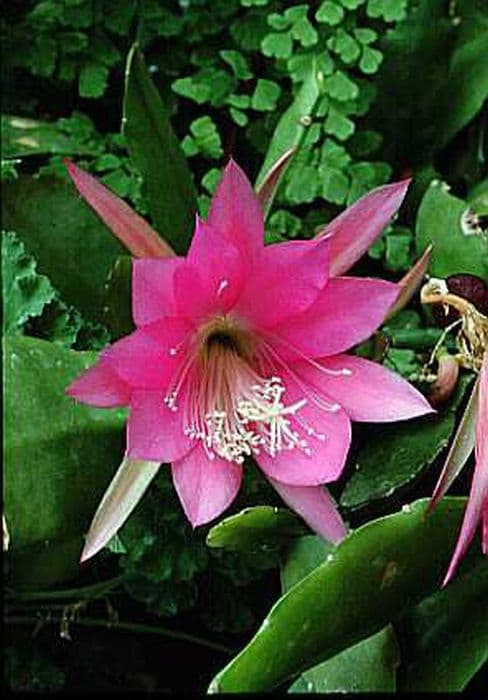Powder Puff Cactus Mammillaria bocasana

ABOUT
The Mammillaria bocasana, commonly known as the Powder Puff Cactus or Powder Puff Pincushion, is a small, rounded plant that is covered in white, hair-like spines which give it a soft, fuzzy appearance. Among these spines are longer, more robust radial spines that can range in color from white to brown. One of the most distinctive features of the Powder Puff Cactus is its white, woolly hair that often appears denser at the top of the plant, lending it that characteristic 'powder puff' look. This cactus produces small, cream-colored to pink flowers which can form a ring around the top portion of the plant when in bloom. The flowers contrast beautifully with the white hairs and the green of the cactus flesh beneath. The fruit it bears is small and generally pinkish-red in color, adding another drop of color to this charming plant. Overall, the Powder Puff Cactus has a soft, rounded shape with a playful texture that makes it a beloved choice for cactus enthusiasts and a delightful addition to any succulent collection.
About this plant
 Names
NamesFamily
Cactaceae
Synonyms
Powder Puff Cactus, Powder Puff Pincushion, Bristle Mound, Snowball Cactus, Fishhooks Cactus
Common names
Chilita bocasana, Ebnerella bocasana, Mammillaria bocasana subs. multilanata, Mammillaria bocasana var. multilanata, Mammillaria bocasana subs. splendens, Neomammillaria bocasana, Neomammillaria bocasana var. multilanata.
 Toxicity
ToxicityTo humans
The Mammillaria bocasana, commonly known as the Powder Puff Cactus, is not considered toxic to humans. There are no significant toxic effects known for ingesting this plant. However, handling the plant should be done with care due to its sharp spines, which can cause irritation or physical injury.
To pets
The Powder Puff Cactus is also not considered toxic to pets. Like with humans, ingestion of this plant typically does not lead to poisoning. Nonetheless, the spines of the cactus can cause physical injuries or irritation if a pet interacts with the plant, so it is still advisable to keep the plant out of reach of curious pets.
 Characteristics
CharacteristicsLife cycle
Perennials
Foliage type
Evergreen
Color of leaves
Green
Flower color
White
Height
6 inches (15 cm)
Spread
6 inches (15 cm)
Plant type
Cactus
Hardiness zones
9
Native area
Mexico
Benefits
 General Benefits
General Benefits- Easy Maintenance: Mammillaria bocasana, commonly known as Powder Puff Cactus, is low maintenance, making it ideal for beginner gardeners and those who prefer plants that don't require constant care.
- Decorative Appeal: With its white, hair-like spines and pink flowers, the Powder Puff Cactus adds aesthetic value and a touch of nature to any indoor space.
- Drought Tolerant: As a succulent, it is highly drought-tolerant, storing water in its tissues and requiring infrequent watering, which can be especially beneficial in arid climates.
- Small Size: Its compact size makes it suitable for small spaces, desktops, windowsills, and terrariums, as well as for cultivating in small pots.
- Pest Resistance: The Powder Puff Cactus is relatively resistant to pests, reducing the need for pesticides and making it a more sustainable plant choice.
- Long-Lived: Being a cactus, Mammillaria bocasana can live for many years, often outliving many other houseplants with proper care.
- Adaptability: This cactus can adapt to a variety of lighting conditions, although it thrives best in bright light. This versatility makes it suitable for different indoor environments.
 Medical Properties
Medical Properties- This plant is not used for medical purposes.
 Air-purifying Qualities
Air-purifying QualitiesThis plant is not specifically known for air purifying qualities.
 Other Uses
Other Uses- The common name "Powder Puff Cactus" refers to its appearance, and it can be used as an ornamental plant for tabletops or miniature gardens due to its small size and fluffy look, adding a touch of whimsy to the decor.
- As a desert plant, the Powder Puff Cactus can be utilized in xeriscaping, a landscaping technique that reduces or eliminates the need for supplemental water from irrigation.
- Its distinctive texture and spherical shape make the Powder Puff Cactus a popular subject for botanical illustrations and educational materials about desert flora.
- The plant can be part of a terrarium or fairy garden setup, often serving as a faux miniature tree or bush within these miniature landscapes.
- Bonsai enthusiasts sometimes use Powder Puff Cactus as a bonsai plant due to its manageable size and interesting form.
- It can serve as an educational tool for teaching children and students about plant care, desert ecosystems, and the importance of water conservation.
- Photographers may use the Powder Puff Cactus as a prop in photo shoots to create a southwestern or desert theme.
- The flowers produced by the Powder Puff Cactus are used in craft projects, such as creating dried flower arrangements, due to their vibrant hues and small size.
- Enthusiasts of feng shui sometimes incorporate the Powder Puff Cactus into their home layouts, as it is believed that spiky plants can ward off negative energy.
- Because of its hardy nature, the Powder Puff Cactus is sometimes employed in botanical research to study adaptations of succulents in arid conditions.
Interesting Facts
 Feng Shui
Feng ShuiThe Powder Puff Cactus is not used in Feng Shui practice.
 Zodiac Sign Compitability
Zodiac Sign CompitabilityThe Powder Puff Cactus is not used in astrology practice.
 Plant Symbolism
Plant Symbolism- Resilience - Mammillaria bocasana, commonly known as Powder Puff Cactus, demonstrates resilience by thriving in harsh, arid environments where other plants may fail to survive.
- Protection - The cactus is covered in spines, which symbolize a form of natural defense and thus protection from external threats.
- Independence - As a succulent that stores water, the Powder Puff Cactus represents the ability to self-sustain and indicates strong independence.
- Endurance - The plant's ability to withstand long periods without water signifies endurance and the capacity to overcome difficulties.
 Water
WaterFor Powder Puff Cactus, water should be given sparingly as the plant is drought tolerant. During the growth season, from spring to early fall, water every 1-2 weeks, allowing soil to dry out between waterings. Use approximately 2-4 ounces of water each time for small pots, adjusting for larger pots but always ensuring not to overwater. In winter, reduce watering to once a month or less, depending on humidity levels. Overwatering can lead to root rot, so it's crucial to ensure good drainage.
 Light
LightPowder Puff Cactus thrives best in bright indirect light or partial shade. It can tolerate direct sunlight, especially in the morning, but should be protected from the harsh afternoon sun to avoid scorching. A south-facing or east-facing window is an ideal spot for this cactus, providing it with the necessary light without being too intense.
 Temperature
TemperaturePowder Puff Cactus prefers warmer temperatures, doing well between 70 and 80 degrees Fahrenheit. It can survive minimum temperatures of 45 degrees Fahrenheit during its dormant winter period. However, consistently cold temperatures or frost can harm the plant, so it should be kept indoors or in a warm, sheltered place if outdoor temperatures drop below the minimum threshold.
 Pruning
PruningPruning is generally not necessary for Powder Puff Cactus. However, if there is dead or damaged tissue, it can be carefully removed to maintain the plant's health. The best time for pruning, if needed, is during the growing season when the plant can recover quickly. Pruning is seldom required and should be done minimally to avoid causing stress to the plant.
 Cleaning
CleaningAs needed
 Soil
SoilPowder Puff Cactus thrives in a well-draining soil mix consisting of equal parts potting soil, coarse sand, and perlite or pumice. The ideal pH range for this cactus is around 6.0 to 7.5, slightly acidic to neutral.
 Repotting
RepottingPowder Puff Cactus should be repotted every 2-3 years or when it outgrows its current pot. It's best to repot during the spring or summer months.
 Humidity & Misting
Humidity & MistingPowder Puff Cactus prefers low humidity levels typical of arid environments; it thrives in indoor environments with average household humidity levels.
 Suitable locations
Suitable locationsIndoor
Place Powder Puff in bright, indirect light and low humidity.
Outdoor
Grow in bright shade; shelter from harsh sun and heavy rain.
Hardiness zone
9-11 USDA
 Life cycle
Life cycleThe life of a Mammillaria bocasana, commonly known as Powder Puff Cactus, begins as a small seed that germinates in warm temperatures with minimal water. Upon successful germination, a tiny seedling emerges, and as it matures, it develops characteristic spines and globular green stems, which are capable of photosynthesis. The Powder Puff Cactus enters a growth period where it may produce offsets, or "pups," around its base, thus increasing its size clonally. Once mature, the cactus blooms with small, white or pale pink flowers surrounding the crown of the stem, typically during spring or summer. After pollination, which is often aided by insects, the flowers develop into small, club-shaped fruit containing seeds. These seeds, once dispersed, can initiate the life cycle anew if they find a suitable environment for germination.
 Propogation
PropogationPropogation time
Spring-Early Summer
Mammillaria bocasana, commonly known as Powder Puff Cactus, can be propagated most effectively through the process of seed sowing. The best time to propagate by seed is during warm seasons, particularly in spring and summer when temperatures facilitate optimal germination. To propagate Powder Puff Cactus by seed, one needs to fill a pot with a well-draining cactus mix and sow the seeds on the surface. The seeds require light to germinate, so they should not be covered with soil but can be lightly pressed into the medium. The pot should then be placed in a warm location with indirect light and covered with a clear plastic wrap or a propagator lid to maintain humidity. Consistent moisture is necessary, so the soil should be kept lightly moist but not waterlogged. Germination can take anywhere from a week to several months, and once seedlings appear, the plastic can be gradually removed to acclimate them to the environment.









